Abstract
Cadmium has been recognized as a strong environmental pollutant. Exposure to this heavy metal occurs through the intake of foodstuffs, drinking water and also via the inhalation of air. Present study was conducted to evaluate the protective effect of a 43 kDa protein, isolated from the leaves of the herb Cajanus indicus, against cadmium-induced cytotoxicity in hepatocytes. For this study, cadmium chloride (CdCl2) has been used as the source of cadmium. Treatment of hepatocytes with 800 μM CdCl2 for 3 h caused significant reduction in cell viability in association with the increased levels of glutamate pyruvate transaminase (GPT) and alkaline phosphatase (ALP) leakage. The activities of the antioxidant enzymes, superoxide dismutase, catalase (CAT), glutathione-S-transferase and glutathione reductase, and the levels of cellular metabolites, reduced glutathione (GSH) as well as total thiols have also been decreased under the same treatment. In addition, the toxin enhanced the levels of the lipid peroxidation end products and oxidized glutathione (GSSG). Incubation of hepatocytes with the protein at a dose of 0.1 mg/ml for 3 h prior to the toxin treatment (at a dose of 800 μM for 3 h) restored the activities of all the antioxidant enzymes, the levels of GSH, total thiols, cell viability and also attenuated the increased levels of GPT, ALP, lipid peroxidation and GSSG. In addition, the protein resisted CdCl2 induced alterations of all the parameters when applied in combination with CdCl2. Effects of a known antioxidant, vitamin E, and a non-relevant protein, bovine serum albumin against CdCl2 induced cytotoxicity have also been included in the study. Combining all, we would like to say that the protein possessed protective activity against CdCl2 induced cytotoxicity in mouse hepatocytes probably via its antioxidant property.

Similar content being viewed by others
References
Akbay A, Cinar K, Uzunalimoglu O, Eranil S, Yurdaydin C, Bozkaya H, Bozdayi M (1999) Serum cytotoxin and oxidant stress markers in N-acetylcysteine treated thioacetamide hepatotoxicity in rats. Hum Exp Toxicol 18:669–676
Allen RG, Balin AK (1989) Oxidative influence in development and differentiation: an over view of a free radical theory of development. Free Radic Biol Med 6:631–661
Anandan R, Rekha RD, Debaki T (1999) Preotestive effect of Picrorrhiza kurroa on mitochondrial glutathione antioxidant system in d-galactodsamine induced hepatitis in rats. Curr Sci 76:1543–1545
ATSDR (Agency for Toxic Substances and Disease Registry) (1994) Case studies in environmental medicine: cadmium toxicity, Atlanta, GA
ATSDR (Agency for Toxic Substances and Disease Registry) (1989) Toxicological profile for cadmium. ATSDR/US Public Health Service, ATSDR/TP-88/08
Babior BM (1992) The respiratory burst oxidase. Adv Enzymol Relat Areas Mol Biol 65:49–65
Block C, Freyermuth S, Beyersmann D, Malviya AN (1992) Role of cadmium in activating nuclear protein kinase C and the enzyme binding to nuclear protein. J Biol Chem 267:19824–19828
Bonaventura J, Schroeder WA, Fang S (1972) Human erythrocyte catalase: an improved method of isolation and a revaluation of reported properties. Arch Biochem Biophys 150:606–617
Bradford MM (1976) A rapid and sensitive method for the quantitation of microgram quantities of protein utilizing the principle of protein-dye binding. Anal Biochem 72:248–254
Bruck R, Aeed H, Avni Y, Shirin H, Matas Z, Shahmurov M, Avinoach I, Zozulya G, Weizman N, Hochman A (2004) Melatonin inhibits nuclear factor kappa B activation and oxidative stress and protects against thioacetamide induced liver damage in rats. J Hepatol 40:86–93
Bruck R, Aeed H, Schey R, Matas Z, Raifen R, Zaiger G, Hochman A, Avni Y (2002) Pyrrolidine dithiocarbamate protects against thioacetamide induced fulminant hepatic failure in rats. J Hepatol 36:370–377
Chan HM, Cherian MG (1992) Protective roles of metallothionein and glutathione in hepatotoxicity of cadmium. Toxicology 72:281–290
Chen L, Zhou J, Gao W, Jiang YZ (2003) Action of NO and TNF-alpha release of rats with cadmium loading in malfunction of multiple system organ. Sheng Li Xue Bao 55:535–540
Choudhuri BR, Poddar MK (1984) Andrographolide and kalmegh (Andrographis paniculata) extract: in vivo and in vitro effect on hepatic lipid peroxidation. Methods Find Exp Clin Pharmacol 6:481–485
de Hann JB, Cristino F, Ianello R, Bladier C, Kelner MJ, Kola I (1996) Elevation in the ratio of Cu/Zn superoxide dismutase to glutathione peroxidase activity induces features of cellular senescence and this effect is mediated by hydrogen peroxide. Hum Mol Genet 5:283–292
Del Raso N (1992) In vitro methods for assessing chemical or drug toxicity and metabolism in primary hepatocytes. In: Watson RR (ed) In vitro methods of toxicology. CRC Press Inc., Boca Raton, pp 176–201
Diez-Fernandez C, Sanz N, Alvarez AM, Zaragoza A, Cascales M (1998) Influence of aminoguanidine on parameters of liver injury and regeneration induced in rats by a necrogenic dose of thioacetamide. Br J Pharmacol 125:102–108
Edmund C So, Wong Kar-lok, Huang Tian-chyuan, Tasi Sheng-chou, Liu Chi-feng (2002) Tetramethylpyrazine protects mice against thioacetamide induced acute hepatotoxicity. J Biomed Sci 9:410–414
Elez D, Dundjerski J, Matic G (2001) Cadmium affects the redox state of rat liver glucocorticoid receptor. Cell Biol Toxicol 17:169–177
Ellman GL (1959) Tissue sulfhydryl group. Arch Biochem Biophys 82:70–77
Esterbauer H, Cheeseman KH (1990) Determination of aldehydic lipid peroxidation products: malonaldehyde and 4-hydroxynonenal. Methods Enzymol 186:407–421
Farghali H, Kamenikova L, Hynie S, Kmonickova E (2000) Silymarin effects on intracellular calcium and cytotoxicity: a study in perfused rat hepatocytes after oxidative stress injury. Pharmacol Res 41:231–237
Gennari A, Cortese E, Boveri M, Casado J, Prieto P (2003) Sensitive endpoints for evaluating cadmium-induced acute toxicity in LLC-PK1 cells. Toxicology 183:211–220
Ghosh A, Biswas K (1973) Bhartiya Banausadhi, vol 2. Chatterjee A (ed) Calcutta University Press, Calcutta, pp 332–334
Ghosh A, Sil PC (2006) A 43 kD protein from the leaves of the herb, Cajanus indicus L., modulates chloroform induced hepatotoxicity in vitro. Drug Chem Toxicol 29:397–413
Habig WH, Jakoby WB (1974) Glutathione S-transferases. The first enzymatic step in mercapturic acid formation. J Biol Chem 249:7130–7139
Hissin PJ, Hilf RA (1976) A fluorometric method for determination of oxidized and reduced glutathione in tissues. Anal Biochem 74:214–226
Hockenbery DM, Oltwai ZN, Yin XM, Milliman CL, Korsmeyer SJ (1993) Bcl-2 functions in an antioxidant pathway to prevent apoptosis. Cell 22:241–251
Hsiao CJ, Stapleton SR (2004) Characterization of Cd-induced molecular events prior to cellular damage in primary rat hepatocytes in culture: activation of the stress activated signal protein JNK and transcription factor AP-1. J Biochem Mol Toxicol 18:133–142
IARC (International Agency for Research on Cancer) (1993) Beryllium, cadmium, mercury, and exposure in the glass manufacturing industry. In: Monographs on the evaluation of the carcinogenic risks to humans, vol 58. IARC Scientific Publications, Lyon, pp 119–237
Jamal IS, Smith JC (1985) Effects of cadmium on glutathione peroxidase, superoxide dismutase and lipid peroxidation in the rat heart: a possible mechanism of cadmium cardiotoxicity. Toxicol Appl Pharmacol 80:33–42
Kakkar P, Das B, Viswanathan PN (1984) A modified spectrophotometric assay of superoxide dismutase. Indian J Biochem Biophys 21:130–132
Kang JS, Jeon YJ, Park SK, Yang KH, Kim HM (2004) Protection against lipopolysaccharide-induced sepsis and inhibition of interleukin-1 beta and prostaglandin E2 synthesis by silymarin. Biochem Pharmacol 67:175–181
Karthikeyan K, Sarala Bai BR, Gauthaman K, Sathish KS, Niranjali Devaraj S (2003) Cardioprotective effect of the alcoholic extract of Terminalia arjuna bark in an in vivo model of myocardial ischemic reperfusion injury. Life Sci 73:2727–2739
Kind PRN, King EJ (1954) Estimation of plasma phosphatase by determination of hydrolysed phenol with anti-pyrine. J Clin Pathol 7:322–326
Klassen CD, Liu J (1997) Role of metallothionein in cadmium-induced hepatotoxicity and nephrotoxicity. Drug Metab Rev 29:79–102
Koizumi T, Shirakura H, Kumagai H, Tatsumoto H, Suzuki KT (1996) Mechanism of cadmium-induced cytotoxicity in rat hepatocytes: cadmium-induced active oxygen-related permeability changes of the plasma membrane. Toxicology 114:125–134
Lecoeur S, Huynh DC, Blais A, Duche A, Tome D, Kolf CM (2002) Implication of distinct proteins in cadmium uptake and transport by intestinal cells HT-29. Cell Biol Toxicol 18:409–423
Mates JM, Perez-Gomez C, Nunez de Castro I (1999) Antioxidant enzymes and human diseases. Clin Biochem 32:595–603
Nishikimi M, Rao NA, Yagi K (1972) The occurrence of superoxide anion in the reaction of reduced phenazine methosulfate and molecular oxygen. Biochem Biophys Res Commun 46:849–854
Reitman S, Frankel S (1957) A colorimetric method for the determination of serum glutamic oxalacetic and glutamic pyruvic transaminases. Am J Clin Pathol 28:56–63
Risso de Faverney C, Orsini N, De Sousa G, Rahmani R (2004) Cadmium-induced apoptosis through the mitochondrial pathway in rainbow trout hepatocytes: involvement of oxidative stress. Aquat Toxicol 69:247–258
Sarkar S, Yadav P, Trivedi R, Bansal AK, Bhatnagar P (1995) Cadmium-induced lipid peroxidation and the status of the antioxidant system in the rat. J Trace Elem Med Biol 9:144–149
Sarkar S, Yadav P, Bhatnager D (1997) Cadmium-induced lipid peroxidation and the antioxidant system in rat erythrocytes: the role of antioxidants. J Trace Elem Med Biol 11:8–13
Sarkar K, Ghosh A, Sil PC (2005) Preventive and curative role of a 43 kD protein from the leaves of the herb Cajanus indicus L. on thioacetamide-induced hepatotoxicity in vivo. Hepatol Res 33:39–49
Sarkar K, Sil PC (2006) A 43 kDa protein from the herb Cajanus indicus L. protects thioacetamide induced cytotoxicity in hepatocytes. Toxicol In Vitro 20:634–640
Sarkar K, Sil PC (2007) Attenuation of acetaminophen-induced hepatotoxicity in vivo and in vitro by a 43 kD protein isolated from the herb, Cajanus indicus L. Toxicol Mech Methods (in press)
Sarkar K, Ghosh A, Kinter A, Mazumder B, Sil PC (2006) Purification and characterization of a 43 kD hepatoprotective protein from the herb Cajanus indicus L. Protein J 25:411–421
Satarug S, Haswell Elkins MR, Moore MR (2000) Safe levels of cadmium intake to prevent renal toxicity in human subjects. Br J Nutr 84:791–802
Schoeters G, Den Hond E, Zuurbier M, Naginiene R, Van Den Hazel P, Stilianakis N, Ronchetti R, Koppe JG (2006) Cadmium and children: exposure and health effects. Acta Paediatr Suppl 95:50–54
Sedlak J, Lindsay RH (1968) Estimation of total, protein-bound, and non protein sulfhydryl groups in tissue with Ellman’s reagent. Anal Biochem 24/25:192–205
Shibanuma M, Kuroki T, Nose K (1990) Stimulation by hydrogen peroxide of DNA synthesis, competence family gene expression and phosphorylation of a specific protein in quiescent Balb/3t3 cells. Oncogene 5:1025–1032
Smith IK, Vierheller TL, Thorne CA (1988) Assay of glutathione reductase in crude tissue homogenates using 5,5′-dithiobis (2-nitrobenzoic acid). Anal Biochem 175:408–413
Sun Y (1990) Free radicals, antioxidant enzymes and carcinogenesis. Free Radic Biol Med 8:583–599
Unander DW, Webster GL, Blumberg BS (1995) Usage and bioassays in Phyllanthus (Euphorbiaceae) IV. Clustering of antiviral uses and other effects. J Ethnopharmacol 45:1–18
Waalkes MP (2003) Cadmium carcinogenesis. Mutat Res 533:107–120
Acknowledgment
The work has partly been supported by the Department of Atomic Energy (DAE), Government of India (a Grant-in-Aid to PCS, Sanction no. 2002/37/35/BRNS/2065). PM acknowledges the receipt of a UGC ad-hoc fellowship. MS acknowledges the receipt of financial support from DAE. The authors are grateful to the Director of Bose Institute for providing the laboratory facilities and Mr. Prasanta Pal for excellent technical assistance for the study.
Author information
Authors and Affiliations
Corresponding author
Additional information
Mahua Sinha and Prasenjit Manna contributed equally in the study.
Rights and permissions
About this article
Cite this article
Sinha, M., Manna, P. & Sil, P.C. Attenuation of cadmium chloride induced cytotoxicity in murine hepatocytes by a protein isolated from the leaves of the herb Cajanus indicus L.. Arch Toxicol 81, 397–406 (2007). https://doi.org/10.1007/s00204-007-0176-7
Received:
Accepted:
Published:
Issue Date:
DOI: https://doi.org/10.1007/s00204-007-0176-7




